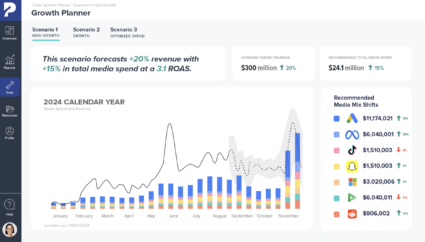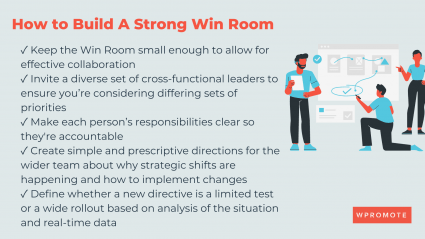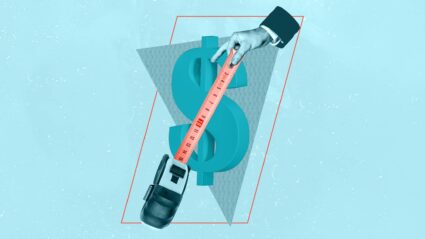So far in 2025, we’ve seen tariffs announced, reversed, and reapplied; rising inflation; and plummeting consumer sentiment.
Whether or not you think we’re headed for a full-blown recession, it’s safe to say the economy is volatile. But that doesn’t mean your brand has to take a hit.
One of the best ways to minimize risk and score opportunistic wins: strategic scenario planning. By thinking ahead and building an agile media strategy, you can plan for fluctuations and react quickly to changes when it matters most.
With the right preparation, your team will be ready to swim when competitors sink.
Scope it out: defining your base, stress, and upside scenarios
First, you’ll need to map out the external factors that would positively or negatively impact your brand. These are your “what-ifs,” such as shifts in consumer spending, inflation, tariffs, and unemployment.
Start by defining your base, stress, and upside scenarios. Then, you can break those stress and upside scenarios down into mild, moderate, and severe versions if you need more precision.
Here’s an example of what those scenarios could look like:
- Base Scenario: Represents most likely assumptions (this will be your benchmark).
- Stress Scenario: Accounts for possible adverse conditions like increased tariffs (+10%), higher CPMs (+15%), and decreased demand (-5%). Depending on your needs, you may want to develop additional scenarios such as:
- Mild Stress: +5% tariffs, +10% CPM, −2% demand
- Severe Stress: +20% tariffs, +25% CPM, −10% demand
- Upside Scenario: Reflects favorable conditions, such as reduced CPM costs (-10%) due to decreased competition and increased demand (+3%). You might want to add variations such as:
- Mild Upside: −5% CPM, +1% demand
- Big Upside: −15% CPM, +5% demand
Connecting the dots: modeling scenarios
Once you have your external scenarios defined, your team should connect those “what if” inputs to internal levers like changes to media investment (spend up/down, channel shifts, etc.), pricing strategy updates, promotional cadence, margin compression, or cost of goods sold.
Finally, to approximate business impact under these different scenarios, your model should leverage historical performance data (like Google Analytics and platform performance); CAC, LTV, and AOV trends; and industry benchmarks (from sources like Wpromote’s Polaris IQ Benchmark Explorer or Forrester reports).
You can simulate results across scenarios and answer key questions like:
- “Do we still hit our ROI goal?”
- “What volume can we sustain?”
- “What happens if our top channel underperforms?”
Take it up a notch with MMM
Even simple tools like well-structured Excel models can model these scenarios, but implementing a media mix model (MMM) takes this process to the next level, making it faster and easier while yielding more timely and accurate insights.
What can MMM do for your brand?
MMM is a holistic measurement approach advertisers use to determine cross-channel lift driven across all marketing efforts. It can help you find the optimal media mix across every channel and platform and forecast the budget you need.
MMMs predict future investment impact by combining your historical performance data, non-media variables like economic assumptions, inventory changes, and more to be as accurate as possible.
If you have access to an MMM, you may be off to the races–but only if it delivers actionable insights before the data gets stale. Developing this kind of model takes years of data, which many marketers don’t have. High-velocity MMMs like Wpromote’s Polaris IQ Growth Planner can help: these models can leverage massive amounts of data, computing power, and automation to speed up and enhance the MMM process.

Think fast: agile decision-making processes
Planning is all well and good, but most businesses aren’t ready to make the kind of quick pivots necessary to win in a changing economic landscape. How will your brand respond when it’s time for action?
Agile decision-making processes and frameworks make it easier to reallocate budget swiftly and immediately respond to market shifts. One way to make sure your experts are sharing information, exchanging ideas, and efficiently communicating with each other is by establishing a Win Room.
Your Win Room should consist of a weekly session that includes a small group of cross-functional stakeholders with clear responsibilities who take a holistic view of your marketing plans, evaluate new data points, and figure out what needs to change.

Act fast: adjust in real time with flexible budget and creative
Once your team is ready to collaborate quickly, you should start preparing your budget and creative assets for different key scenarios so you can take action when you need to.
Adapting the creative process
Updating creative fast can be a major challenge for many teams. The creative process often involves multiple stakeholders and approvals, which can slow down production.
To make an adaptable creative strategy, you’ll need to have a plan in advance for how you’ll adjust to changes. Start by having a conversation with your team about potential pivots so you can figure out what kind of messaging your company is comfortable sharing and what active conversations you’re willing to participate in versus those you’d like to avoid commenting on.
If everyone is on the same page, your team can be more confident (and faster) when making new creative.
You should also outline a quick approval process for when you need to make creative moves fast. Decide how approvals can be accelerated and who really needs to be looped in (and, maybe more importantly, who doesn’t need to be looped in) on any changes to streamline your process.
If possible, it’s a good idea to have multiple versions of your creative and messaging (especially on social and search) ready to be approved ahead of time so you can move even more quickly.
Unlock budget flexibility
During a time of economic instability, a flexible budget is critical. The last thing you want is to have your decisions hindered by a budget that falls short.
To get that flexibility, you usually have to start by making the case to finance. That can be easier said than done, but it’s worth fighting for the money your team needs to keep up with changes like tariffs or inflation before they happen.
Prioritize getting a dedicated testing budget of at least 10% and put that money in the hands of a dedicated owner so someone is always held accountable for protecting and using that budget.
But remember, flexibility in budget doesn’t just mean the amount of money you’re spending; it’s also about where you’re spending it. Ask yourself: “How are we setting up fluidity with partners so we can shift money quickly?”
Your original plan is just a starting point, not a hard and fast rule. In times like these, you need to be ready to make changes whenever necessary.








Responses